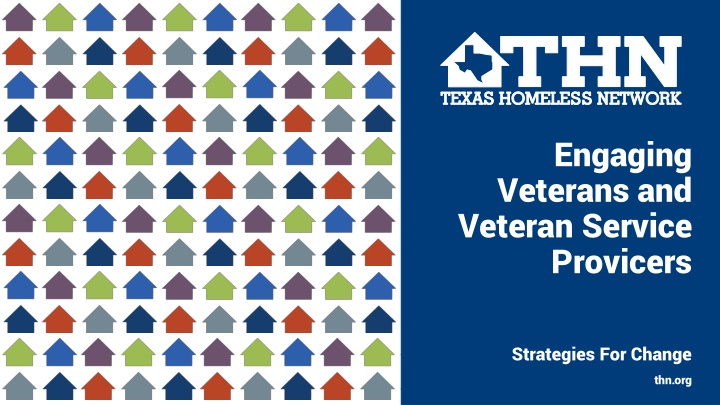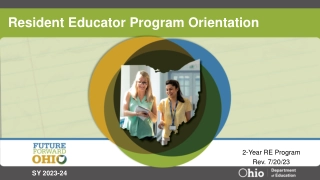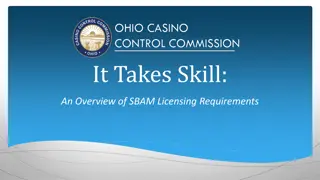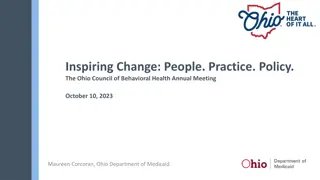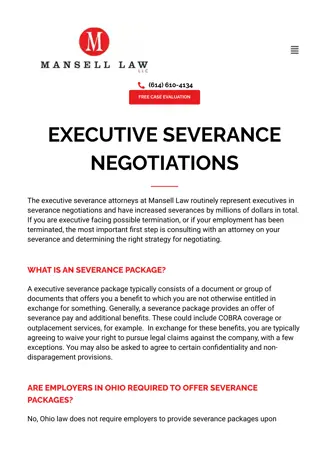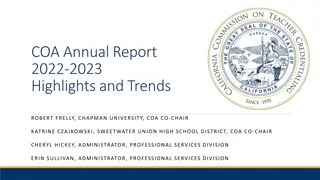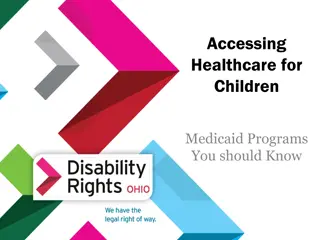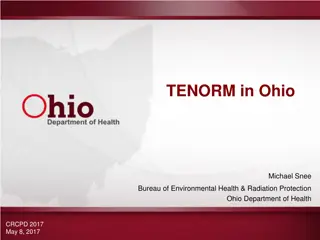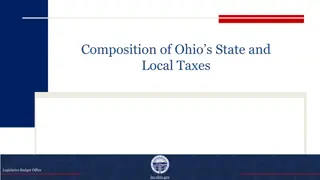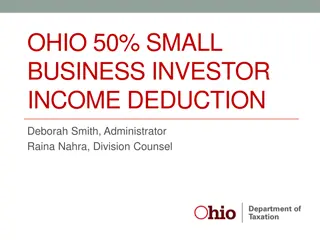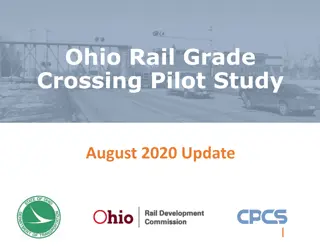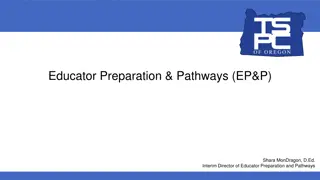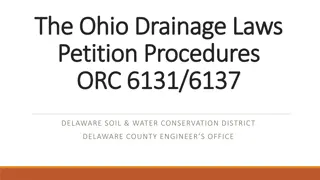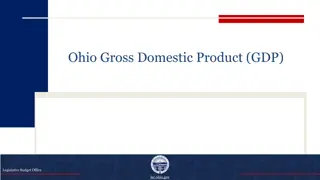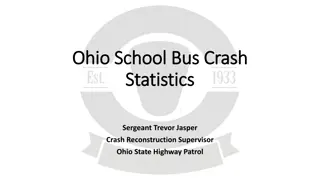Addressing Educator Shortages Program in Ohio
This program in Ohio aims to address educator shortages by providing funding through a competitive review process for eligible institutions to increase educator candidates and combat shortages. Scholarships, eligible expenses, and proposal requirements are key components of this initiative.
Download Presentation

Please find below an Image/Link to download the presentation.
The content on the website is provided AS IS for your information and personal use only. It may not be sold, licensed, or shared on other websites without obtaining consent from the author.If you encounter any issues during the download, it is possible that the publisher has removed the file from their server.
You are allowed to download the files provided on this website for personal or commercial use, subject to the condition that they are used lawfully. All files are the property of their respective owners.
The content on the website is provided AS IS for your information and personal use only. It may not be sold, licensed, or shared on other websites without obtaining consent from the author.
E N D
Presentation Transcript
Engaging Veterans and Veteran Service Provicers Strategies For Change thn.org
Module 1 Module 2 Module 3 Winter PIT Count Date: Module 4 1/23/2025 Module 5 Module 6 Wrap- Up
Module 1 Agenda Module 2 Introduction Importance of the PIT Count Collaboration During the Count After the Count Next Steps Module 3 Module 4 Module 5 Module 6 Wrap- Up
Introduction Module 2 This document compiles feedback from several communities as well as larger efforts. Listed at the end of this document are just a few resources that communities can use to analyze and improve their existing process. This tool is not mean to be a comprehensive guide on conducting the Point-in-Time (PIT) count. It is a supplemental resource that was developed specifically to assist with ensuring veterans are accounted for on the day of the PIT. If you have questions, concerns, or feedback on the information in this presentation please reach out to the THN Data Coordinator. Module 3 Module 4 Module 5 Module 6 Wrap- Up
Rate of Homelessness Module 2 Just over 9% of all adults experiencing homelessness in the United States are Veterans of the U.S. military. - USICH Module 3 Module 4 This data point is one of the many nationally recognized statistics around homelessness and was calculated solely by using PIT Data Module 5 Module 6 Wrap- Up
Veterans in Texas Module 2 1 The population of Veterans in Texas: 1,573,737 Did you know that two counties are in the top 100 counties in the United States where Veterans live? The TX BoS CoC is home to 49% of the total Veteran Population in Texas: 769,498 Of these veterans, 555 2 within the Texas Balance of State Module 3 Module 4 1Veterans live in the TX BoS CoC Region 3 were identified on the 2020 PIT Count. 4 Module 5 1Citation: Veterans in Texas: A Demographic Study (hyperlinked) 2Citation: VA County Level Veteran Data (hyperlinked) 3Citation: Extrapolated PIT Report (hyperlinked) 4Based on the data on the previous slide and our understanding of veteran homelessness, we believe this is an undercount. Module 6 Wrap- Up
PIT Count Importance The Point-in-Time (PIT) Count is an annual effort led by the U.S. Department of Housing and Urban Development (HUD) to estimate the number of Americans, including Veterans, without safe, stable housing. Module 3 It is one of the tools used to assess progress each year toward VA s priority goal of ending homelessness among Veterans. Module 4 Counting every homeless sheltered and unsheltered veterans is key to understanding whether community efforts to effectively end homelessness for veterans are working, and whether fewer veterans are experiencing homelessness over time. Module 5 Module 6 Wrap- Up
Key Considerations Conducting a PIT count of homeless veterans is challenging because a person s veterans status is not visibly discernible and identification will likely require enumerator interviews. Locating, counting, and interviewing unsheltered homeless veterans during the PIT count is a major challenge However, those responsible for planning the PIT count should be mindful that some veterans might not be eligible for VA services, so it is important that other partners (in addition to the VA) participate to identify and locate homeless veterans. Ultimately, combining homeless sector and VA knowledge will result in a more thorough and accurate count. Module 3 Module 4 Module 5 Module 6 Wrap- Up
Partnerships with the VA 1. Engage the local VA Medical Center and VA department staff that provide services to homeless veterans or work on homeless issues to help plan and implement the count. VA Medical Centers have homeless coordinators and outreach workers who regularly interact with homeless veterans. These staff are knowledgeable about the locations where unsheltered homeless veterans live, sleep, and congregate and can identify the places that must be included in the unsheltered count. These individuals can also help make sure the roster of housing programs for homeless veterans is complete for the sheltered count and identify any other VA-funded service centers that should be involved, such as Community Based Outpatient Clinics (CBOCs), Vet Centers, and Women Vet Programs. Provide guidance on count and survey instruments. VA staff can offer technical guidance to improve data accuracy. Assist during the count. Veteran homeless coordinators and outreach workers can form special teams to canvass encampments and other remote areas that may not have been included in previous counts. Their relationships with clients could also help homeless veterans feel more comfortable providing information. Module 4 Module 5 Module 6 Wrap- Up
Veteran Service Organizations 2. Reach out to local Veteran Service Organizations (e.g. American Legion, Disabled American Veterans) for their cooperation with the count. Especially in rural areas where there may not be many homeless service providers, Veteran Service Organizations (VSOs) provide assistance to homeless veterans and their families. Some VSOs have funds that are set aside to assist these families with motel vouchers and utility payments. Lists of chartered and non-chartered agencies serving homeless and other veterans can be found nationally at the National Resource Directory for Veterans (www.nrd.org) and the National Coalition for Homeless Veterans (www.nchv.org). In addition, every state has a Department of Veteran Affairs or equivalent office that might be able to provide a list of relevant service agencies by location. Module 4 Module 5 Module 6 Wrap- Up
Those with Lived Experience 3. Recruit homeless or formerly homeless veterans to be enumerators for the unsheltered count. Homeless veterans can be an indispensable resource while planning and conducting a PIT count. Before the count, they can assist in identifying those locations where unsheltered homeless veterans may be living. They can also participate in the count itself, as they may be able to gain the trust of homeless veterans more easily than other staff or volunteers and thus have more success completing surveys. Module 4 Module 5 Module 6 Wrap- Up
During the Count Veteran homeless coordinators and outreach workers can form special teams to canvas encampments and other remote areas that might not have been included in previous counts. Healthcare for Homeless Veterans (HCHV) staff may be particularly key in assisting CoCs to have a comprehensive PIT count that includes every homeless veteran, including those who are unsheltered and only being engaged by HCHV staff or who are known to VAMC staff. Locations where homeless veterans go for assistance should be used to conduct surveys: These locations may include: soup kitchens, food pantries, libraries, welfare offices, VAMCs, Vet Centers, Veterans Benefits Administration offices and intake sites. Module 5 Module 6 Wrap- Up
After the PIT Count A promising practice being used by communities around the country is surge canvassing- community partners, local VA staff, and homeless providers cover the geographic area in a community for several consecutive days to locate and identify each veteran experiencing homelessness, and then quickly link them with permanent housing and resources. This concentrated, collaborative effort has been used by national initiatives including 100,000 Homes and 25 Cities Initiative as an effective means of populating an Active list, raising awareness and generating community support for ending veteran homelessness. Citation: HUD Exchange Module 6 Wrap- Up
Next Steps VA staff should first identify each CoC included in the VAMC service area, whether the entire CoC geography is included or just a portion. VA staff should then identify the official CoC and reach out to the regional PIT Lead. PIT Lead s should find their local VA Medical Center Homeless Coordinator PIT Lead s should contact their VA Vet Center Homeless Coordinator Wrap- Up
Resources Veterans HIC/PIT Count Data Guidance Tool Vets@Home Toolkit: Identifying and Engaging Veterans VAMC Homeless Coordinator Locator VA Vet Center Homeless Coordinator Wrap- Up
Contact Information Ava Paredes Data Coordinator Thank you! Email: Ava@THN.org Phone: (512) 652-4714 @THN.org Strategies For Change thn.org
